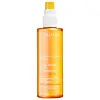What's inside
What's inside
 Key Ingredients
Key Ingredients

 Benefits
Benefits

 Concerns
Concerns

 Ingredients Side-by-side
Ingredients Side-by-side

Titanium Dioxide 4.9%
Cosmetic ColorantZinc Oxide 4.7%
Cosmetic ColorantAlumina
AbrasiveArachidyl Alcohol
EmollientArachidyl Glucoside
EmulsifyingAscorbic Acid
AntioxidantAvena Sativa Kernel Extract
AbrasiveBeeswax
Emulsion StabilisingBehenyl Alcohol
EmollientBenzyl Alcohol
PerfumingBisabolol
MaskingButylene Glycol
HumectantButyloctyl Salicylate
Skin ConditioningCalendula Officinalis Flower Extract
MaskingCamellia Sinensis Leaf Extract
AntimicrobialCarbomer
Emulsion StabilisingCeramide AP
Skin ConditioningCeramide EOP
Skin ConditioningCeramide NP
Skin ConditioningCetyl Dimethicone
EmollientChamomilla Recutita Flower Extract
MaskingCholesterol
EmollientDimethicone
EmollientDimethicone PEG-8 Laurate
Skin ConditioningDipotassium Glycyrrhizate
HumectantDisodium EDTA
Ethylhexylglycerin
Skin ConditioningGlycerin
HumectantGlyceryl Stearate
EmollientHydrated Silica
AbrasiveHydroxyethyl Acrylate/Sodium Acryloyldimethyl Taurate Copolymer
Emulsion StabilisingIsohexadecane
EmollientMaltodextrin
AbsorbentMethicone
EmollientPanthenol
Skin ConditioningPantothenic Acid
Skin ConditioningPEG-100 Stearate
PEG-8
HumectantPhytosphingosine
Skin ConditioningPolyaminopropyl Biguanide
PreservativePolymethyl Methacrylate
Polysorbate 60
EmulsifyingPotassium Sorbate
PreservativePropylene Glycol
HumectantSodium Lauroyl Lactylate
EmulsifyingStearic Acid
CleansingStyrene/Acrylates Copolymer
Tocopheryl Acetate
AntioxidantTriethoxycaprylylsilane
Trimethylsiloxysilicate
EmollientTrisiloxane
Skin ConditioningVp/Eicosene Copolymer
Water
Skin ConditioningXanthan Gum
EmulsifyingTitanium Dioxide 4.9%, Zinc Oxide 4.7%, Alumina, Arachidyl Alcohol, Arachidyl Glucoside, Ascorbic Acid, Avena Sativa Kernel Extract, Beeswax, Behenyl Alcohol, Benzyl Alcohol, Bisabolol, Butylene Glycol, Butyloctyl Salicylate, Calendula Officinalis Flower Extract, Camellia Sinensis Leaf Extract, Carbomer, Ceramide AP, Ceramide EOP, Ceramide NP, Cetyl Dimethicone, Chamomilla Recutita Flower Extract, Cholesterol, Dimethicone, Dimethicone PEG-8 Laurate, Dipotassium Glycyrrhizate, Disodium EDTA, Ethylhexylglycerin, Glycerin, Glyceryl Stearate, Hydrated Silica, Hydroxyethyl Acrylate/Sodium Acryloyldimethyl Taurate Copolymer, Isohexadecane, Maltodextrin, Methicone, Panthenol, Pantothenic Acid, PEG-100 Stearate, PEG-8, Phytosphingosine, Polyaminopropyl Biguanide, Polymethyl Methacrylate, Polysorbate 60, Potassium Sorbate, Propylene Glycol, Sodium Lauroyl Lactylate, Stearic Acid, Styrene/Acrylates Copolymer, Tocopheryl Acetate, Triethoxycaprylylsilane, Trimethylsiloxysilicate, Trisiloxane, Vp/Eicosene Copolymer, Water, Xanthan Gum
C12-15 Alkyl Benzoate
AntimicrobialAlcohol
AntimicrobialOctyldodecanol
EmollientHomosalate
Skin ConditioningOctocrylene
UV AbsorberButyloctyl Salicylate
Skin ConditioningButyl Methoxydibenzoylmethane
UV AbsorberEthylhexyl Salicylate
UV AbsorberPolyester-7
Skin ConditioningNeopentyl Glycol Diheptanoate
EmollientTriisostearin
Skin ConditioningCalophyllum Inophyllum Seed Oil
AntimicrobialParfum
MaskingTocopheryl Acetate
AntioxidantBenzyl Salicylate
PerfumingTocopherol
AntioxidantEthylene Brassylate
MaskingLimonene
PerfumingButylphenyl Methylpropional
PerfumingAloe Barbadensis Leaf Juice
Skin ConditioningButylene Glycol
HumectantGlycerin
HumectantHelianthus Annuus Seed Oil
EmollientWater
Skin ConditioningHexyl Cinnamal
PerfumingCitronellol
PerfumingCassia Alata Leaf Extract
AstringentPhenoxyethanol
PreservativePlatanus Occidentalis Bark Extract
Skin ProtectingCitric Acid
BufferingPotassium Sorbate
PreservativeSodium Benzoate
MaskingC12-15 Alkyl Benzoate, Alcohol, Octyldodecanol, Homosalate, Octocrylene, Butyloctyl Salicylate, Butyl Methoxydibenzoylmethane, Ethylhexyl Salicylate, Polyester-7, Neopentyl Glycol Diheptanoate, Triisostearin, Calophyllum Inophyllum Seed Oil, Parfum, Tocopheryl Acetate, Benzyl Salicylate, Tocopherol, Ethylene Brassylate, Limonene, Butylphenyl Methylpropional, Aloe Barbadensis Leaf Juice, Butylene Glycol, Glycerin, Helianthus Annuus Seed Oil, Water, Hexyl Cinnamal, Citronellol, Cassia Alata Leaf Extract, Phenoxyethanol, Platanus Occidentalis Bark Extract, Citric Acid, Potassium Sorbate, Sodium Benzoate
Ingredients Explained
These ingredients are found in both products.
Ingredients higher up in an ingredient list are typically present in a larger amount.
Butylene Glycol (or BG) is used within cosmetic products for a few different reasons:
Overall, Butylene Glycol is a safe and well-rounded ingredient that works well with other ingredients.
Though this ingredient works well with most skin types, some people with sensitive skin may experience a reaction such as allergic rashes, closed comedones, or itchiness.
Learn more about Butylene GlycolButyloctyl Salicylate is a chemical UV filter structurally similar to octisalate. It is a photostabilizer, SPF booster, emollient and solvent. This ingredient helps evenly spread out ingredients.
According to a manufacturer, it is suitable for pairing with micro Titanium Dioxide, Zinc Oxide, and pigments.
Photostabilizers help stabilize UV-filters and prevents them from degrading quickly.
Learn more about Butyloctyl SalicylateGlycerin is already naturally found in your skin. It helps moisturize and protect your skin.
A study from 2016 found glycerin to be more effective as a humectant than AHAs and hyaluronic acid.
As a humectant, it helps the skin stay hydrated by pulling moisture to your skin. The low molecular weight of glycerin allows it to pull moisture into the deeper layers of your skin.
Hydrated skin improves your skin barrier; Your skin barrier helps protect against irritants and bacteria.
Glycerin has also been found to have antimicrobial and antiviral properties. Due to these properties, glycerin is often used in wound and burn treatments.
In cosmetics, glycerin is usually derived from plants such as soybean or palm. However, it can also be sourced from animals, such as tallow or animal fat.
This ingredient is organic, colorless, odorless, and non-toxic.
Glycerin is the name for this ingredient in American English. British English uses Glycerol/Glycerine.
Learn more about GlycerinPotassium Sorbate is a preservative used to prevent yeast and mold in products. It is commonly found in both cosmetic and food products.
This ingredient comes from potassium salt derived from sorbic acid. Sorbic acid is a natural antibiotic and effective against fungus.
Both potassium sorbate and sorbic acid can be found in baked goods, cheeses, dried meats, dried fruit, ice cream, pickles, wine, yogurt, and more.
You'll often find this ingredient used with other preservatives.
Learn more about Potassium SorbateTocopheryl Acetate is AKA Vitamin E. It is an antioxidant and protects your skin from free radicals. Free radicals damage the skin by breaking down collagen.
One study found using Tocopheryl Acetate with Vitamin C decreased the number of sunburned cells.
Tocopheryl Acetate is commonly found in both skincare and dietary supplements.
Learn more about Tocopheryl AcetateWater. It's the most common cosmetic ingredient of all. You'll usually see it at the top of ingredient lists, meaning that it makes up the largest part of the product.
So why is it so popular? Water most often acts as a solvent - this means that it helps dissolve other ingredients into the formulation.
You'll also recognize water as that liquid we all need to stay alive. If you see this, drink a glass of water. Stay hydrated!
Learn more about Water